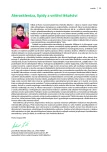What is the contribution of the review of the evidence on reducing macrovascular risk in patients with atherogenic dyslipidemia?
Report on consensus of experts in the importance of the combined therapy by fenofibrate with statin
Authors:
Hana Rosolová
Authors‘ workplace:
Centrum preventivní kardiologie II. interní kliniky LF UK a FN Plzeň, přednosta prof. MUDr. Jan Filipovský, CSc.
Published in:
Vnitř Lék 2015; 61(11): 971-975
Category:
Reviews
Overview
A meeting of European experts in cardiovascular (CV) disease and lipids was convened in Paris, November 2014, where an important problem of preventive cardiology – residual vascular risk done by atherogenic dyslipidemia (AD) – was discussed. On the basis of discussion have the experts summarised a consensus concerning AD, its CV risk and up to date evidence of combined therapy with statin and fenofibrate on CV risk. Atherogenic dyslipidemia should be the secondary aim of dyslipidemia treatment, because it is a reason of residual vascular risk. Non-HDL-cholesterol should be the secondary target of AD treatment, which is a most unexpensive and easiest marker of residual vascular risk. Combined therapy with statin and fenofibrate is safe, well tolerated and reduces plasma atherogenity and CV events in patients with AD and high CV risk, type 2 diabetes or metabolic syndrome.
Key words:
atherogenic dyslipidemia – cardiovascular risk – combined therapy – fenofibrate – statins – triglycerides
Sources
1. Aguiar C, Alegria E, Bonadonna RC et al. A review of the evidence on reducing macrovascular risk in patients with atherogenic dyslipidemia: A report from an expert consensus meeting on the role of fenofibrate-statin combination therapy. Atheroscl Suppl 2015; 19: 1–12. Dostupné z DOI: <http://dx.doi.org/10.1016/S1567–5688(15)30001–5>.
2. Miller M, Cannon CP, Murphy SA et al. Impact of triglyceride levels beyond LDL cholesterol after acute coronary syndrome in the PROVE IT – TIMI 22 trial. J Am Coll Cardiol 2008; 51(7): 724–730.
3. Nordestgaard BG, Varbo A. Triglycerides and cardiovascular disease. Lancet 2014; 384(9943): 626–635.
4. Ginsberg HN, Elam MB, Lovato LC et al. ACCORD Study Group. Effects of combination lipid therapy in type2 diabetes mellitus. N Engl J Med 2010; 362(17): 1563–1574. Erratum in: N Engl J Med 2010; 362(18): 1748.
5. Faergeman O, Holme I, Fayyad R et al. Plasma triglycerides and cardiovascular events in the Treating to New Targets and Incremental Decrease in End Points through Aggressive Lipid Lowering trials of statins in patients with coronary artery disease. Am J Cardiol 2009; 104(4): 459–463.
6. Carey VJ, Bishop L, Laranjo N et al. Contribution of high plasma triglycerides and LDL cholesterol to residual risk of coronary heart disease after establishment of LDL cholesterol control. Am J Cardiol 2010; 106(6): 757–763.
7. Bayturan O, Kapadia S, Nicholls SJ et al. Clinical predictors of plaque progression despite very low levels of LDL cholesterol. J Am Coll Cardiol 2010; 55(24): 2736–2742.
8. Di Angelantonio E, Sarwar N, Perry P et al. Major lipids, apolipoproteins, and risk of vascular disease. JAMA 2009; 302(18): 1993–2000.
9. Sirimarco G, Labreuche J, Bruckert E et al. Atherogenic dyslipidemia and residual cardiovascular risk in statin-treated patients. Stroke 2014; 45(5): 1429–1436.
10. Varbo A, Benn M, Tybjaerg-Hansen A et al. Remnant cholesterol as a causal risk factor for ischemic heart disease. J Am Coll Cardiol 2013; 61(4): 427–436.
11. Jorgensen AB, Frikke-Schmidt R, West AS et al: Genetically elevated non-fasting triglycerides and calculated remnant cholesterol as causal risk factors for myocardial infarction. Eur Heart J 2013; 34(24): 1826–1833.
12. Reyes-Soffer G, Ngai CI, Lovato L et al. Effect of combination therapy with fenofibrate and simvastatin on postprandial lipemia in the ACCORD lipid trial. Diabetes Care 2013; 36(2): 422–428.
13. Zambon A, Puato M, Faggin E et al. Lipoprotein remnants and dense LDL cholesterol are associated with features of unstable plaque: a flag for non-HDL-C. Atherosclerosis 2013; 230(1): 106–109.
14. Scks FM, Hermans MP, Fioretto P et al. Association between plasma triglycerides and HDL cholesterol and microvascular kidney disease and retinopathy in type 2 diabetes mellitus: a global case-control study in 13 countries. Circulation 2014; 129(9): 999–1008.
15. Grundy S, Vega GL, Juan Z et al. Effectiveness and tolerability of Simvastatin plus Fenofibrate for combined hyperlipidemia (The SAFARI Trial). Am J Cardiol 2015; 95(4): 462–468.
16. Keech AC, Simek RJ, Barter P et al. Effects of long-term fenofibrate therapy on cardiovascular events in 9795 people with type 2 diabetes mellitus (the FIELD study): randomised controlled trial. Lancet 2005; 366(9500): 1849–1861.
17. Wright AD, Dodson PM. Medical management of diabetic retinopathy: fenofibrate and ACCORD Eye studies. Eye (Lond) 2011; 25(7): 843–849.
18. Sacks FM, Carey VJ, Fruchart JC et al. Combination lipid therapy in type 2 diabetes. N Engl J Med 2010; 363(7): 684–692.
19. Dobiášová M. AIP aterogenní index plazmy jako významný prediktor kardiovaskulárního rizika: od výzkumu do praxe. Vnitř Lék 2006; 52(1): 64–71.
Labels
Diabetology Endocrinology Internal medicineArticle was published in
Internal Medicine

2015 Issue 11
Most read in this issue
- Clinical importance of basal insulin analogues and insulin Toujeo® 300 units/ml
- Atherosclerosis: from etiology to its possible influencing
- Position of lipoprotein apheresis in present
- Practical approach to statin intolerance
